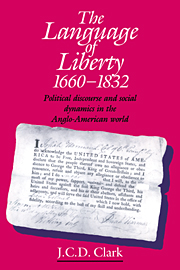 The Language of Liberty 1660–1832
The Language of Liberty 1660–1832 Book contents
- Frontmatter
- Contents
- Preface
- Acknowledgements
- List of abbreviations
- INTRODUCTION: THE STRUCTURE OF ANGLO-AMERICAN POLITICAL DISCOURSE
- 1 THE CONFLICT BETWEEN LAWS: SOVEREIGNTY AND STATE FORMATION IN THE UNITED KINGDOM AND THE UNITED STATES
- 2 THE CONFLICT BETWEEN DENOMINATIONS: THE RELIGIOUS IDENTITY OF EARLY-MODERN SOCIETIES
- 3 PREDISPOSITIONS: REBELLION AND ITS SOCIAL CONSTITUENCIES IN THE ENGLISH ATLANTIC EMPIRE, 1660–1832
- 4 POLITICAL MOBILISATION: THE AMERICAN REVOLUTION AS A WAR OF RELIGION
- CONCLUSION: ‘DESOLATING DEVASTATION’: THE ORIGINS OF ANGLO-AMERICAN DIVERGENCE
- Index
CONCLUSION: ‘DESOLATING DEVASTATION’: THE ORIGINS OF ANGLO-AMERICAN DIVERGENCE
Published online by Cambridge University Press: 29 December 2009
- Frontmatter
- Contents
- Preface
- Acknowledgements
- List of abbreviations
- INTRODUCTION: THE STRUCTURE OF ANGLO-AMERICAN POLITICAL DISCOURSE
- 1 THE CONFLICT BETWEEN LAWS: SOVEREIGNTY AND STATE FORMATION IN THE UNITED KINGDOM AND THE UNITED STATES
- 2 THE CONFLICT BETWEEN DENOMINATIONS: THE RELIGIOUS IDENTITY OF EARLY-MODERN SOCIETIES
- 3 PREDISPOSITIONS: REBELLION AND ITS SOCIAL CONSTITUENCIES IN THE ENGLISH ATLANTIC EMPIRE, 1660–1832
- 4 POLITICAL MOBILISATION: THE AMERICAN REVOLUTION AS A WAR OF RELIGION
- CONCLUSION: ‘DESOLATING DEVASTATION’: THE ORIGINS OF ANGLO-AMERICAN DIVERGENCE
- Index
Summary
British and American society retained much in common in the centuries after 1783: more, indeed, than they were now concerned to assert or willing to admit. Both explored models of democratic politics, were swept by evangelicalism and unbelief, were dominated by the urban-industrial experience. Yet, inexorably, the two societies' self-images and interpretations of their histories drew apart in fundamental ways, so that the demonstration of a ‘special relationship’ required a reinterpretation of the perceived past as much as an evocation of it. Law and religion continued to shape this process by which both America and Britain devised partly-incompatible theories of their own exceptionalism. American understandings of the purpose of the Revolution quickly came after 1776 to turn on religious liberty as the antithesis of tyranny, and on law as the guarantor and definition of liberty; yet, paradoxically, the conflict of denominations steadily increased the authority of the group over the conscience of the individual, and the reconstruction of American law led the courts of the new Republic to develop a far more interventionist and innovatory attitude to their role. Common lawyers in England, in the same half-century after American independence, were increasingly bound by the doctrine of strict construction: Benthamite utilitarianism, not Jeffersonian natural rights, came to describe the truths the English saw as self-evident.
The military outcome of the American Revolution had a profound impact on its interpretation.
- Type
- Chapter
- Information
- The Language of Liberty 1660–1832Political Discourse and Social Dynamics in the Anglo-American World, 1660–1832, pp. 382 - 391Publisher: Cambridge University PressPrint publication year: 1993


